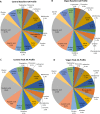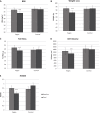A plant-based diet in overweight individuals in a 16-week randomized clinical trial: metabolic benefits of plant protein
- PMID: 30405108
- PMCID: PMC6221888
- DOI: 10.1038/s41387-018-0067-4
A plant-based diet in overweight individuals in a 16-week randomized clinical trial: metabolic benefits of plant protein
Abstract
Background and objectives: A plant-based diet is an effective strategy in the treatment of obesity. In this 16-week randomized clinical trial, we tested the effect of a plant-based diet on body composition and insulin resistance. As a part of this trial, we investigated the role of plant protein on these outcomes.
Subjects and methods: Overweight participants (n = 75) were randomized to follow a plant-based (n = 38) or a control diet (n = 37). Dual X-ray Absorptiometry assessed body composition, Homeostasis Model Assessment (HOMA-IR) assessed insulin resistance, and a linear regression model was used to test the relationship between protein intake, body composition, and insulin resistance.
Results: The plant-based vegan diet proved to be superior to the control diet in improving body weight, fat mass, and insulin resistance markers. Only the vegan group showed significant reductions in body weight (treatment effect -6.5 [95% CI -8.9 to -4.1] kg; Gxt, p < 0.001), fat mass (treatment effect -4.3 [95% CI -5.4 to -3.2] kg; Gxt, p < 0.001), and HOMA-IR (treatment effect -1.0 [95% CI -1.2 to -0.8]; Gxt, p = 0.004). The decrease in fat mass was associated with an increased intake of plant protein and decreased intake of animal protein (r = -0.30, p = 0.011; and r = +0.39, p = 0.001, respectively). In particular, decreased % leucine intake was associated with a decrease in fat mass (r = +0.40; p < 0.001), in both unadjusted and adjusted models for changes in BMI and energy intake. In addition, decreased % histidine intake was associated with a decrease in insulin resistance (r = +0.38; p = 0.003), also independent of changes in BMI and energy intake.
Conclusions: These findings provide evidence that plant protein, as a part of a plant-based diet, and the resulting limitation of leucine and histidine intake are associated with improvements in body composition and reductions in both body weight and insulin resistance.
Conflict of interest statement
The authors declare that they have no conflict of interest.
Figures



References
-
- GBD 2015 Risk Factors Collaborators. Global, regional, and national comparative risk assessment of 79 behavioural, environmental and occupational, and metabolic risks or clusters of risks, 1990–2015: a systematic analysis for the Global Burden of Disease Study 2015. Lancet Lond. Engl. 2016;388:1659–1724. doi: 10.1016/S0140-6736(16)31679-8. - DOI - PMC - PubMed
Publication types
MeSH terms
LinkOut - more resources
Full Text Sources
Medical
Research Materials

